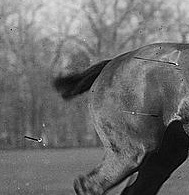
Polo or Chovgan is a ball game that is played on horseback, a traditional field sport and one of the world's oldest known team sports. It originated in ancient Persia, dating back over 2,000 years. Initially played by Persian nobility as a training exercise for cavalry units, polo eventually spread to other parts of the world. The game is played by two opposing teams with the objective of scoring using a long-handled wooden mallet to hit a small hard ball through the opposing team's goal. Each team has four mounted riders, and the game usually lasts one to two hours, divided into periods called chukkas or chukkers.

The Highland Pony is a native Scottish pony, and is one of the largest of the mountain and moorland pony breeds of the British Isles. Its pedigree dates back to the 1880s. It was once a workhorse in the Scottish mainland and islands, but today is used for driving, trekking and general riding. They are hardy and tough, they rarely require shoeing, and are economical to keep.

The Hackney pony is a breed of pony closely related to the Hackney horse. Originally bred to pull carriages, they are used today primarily as show ponies. The breed does not have its own stud book, but shares one with the Hackney horse in all countries that have an official Hackney Stud Book Registry.

The Criollo, or Crioulo, is the native horse of the Pampas with a reputation for long-distance endurance linked to a low basal metabolism. The breed, known for its hardiness and stamina, is popular in its home countries.
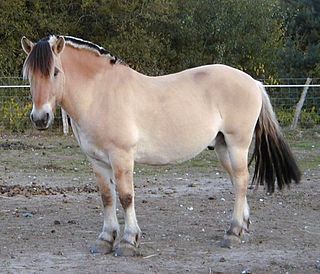
The Fjord or Norwegian Fjord Horse is a relatively small but very strong horse breed from the mountainous regions of western Norway. It is an agile breed of light draught horse build. It is always dun in colour, with five variations in shade recognised in the breed standard. One of the world's oldest breeds, it has been used for hundreds of years as a farm horse in Norway, and in modern times is popular for its generally good temperament. It is used both as a harness horse and under saddle.

The Welsh Pony and Cob is a group of four closely-related horse breeds including both pony and cob types, which originated in Wales. The four sections within the breed society for the Welsh breeds are primarily distinguished by height, and also by variations in type: the smallest Welsh Mountain Pony ; the slightly taller but refined Welsh Pony of riding type popular as a children's show mount; the small but stocky Welsh Pony of Cob Type, popular for riding and competitive driving; and the tallest, the Welsh Cob, which can be ridden by adults. Welsh ponies and cobs in all sections are known for their good temperament, hardiness, and free-moving gaits.

The Hunter division is a branch of horse show competition that is judged on the horse's performance, soundness and when indicated, conformation, suitability or manners. A "show hunter" is a horse that competes in this division.

Hunt seat is a style of forward seat riding commonly found in North American horse shows. Along with dressage, it is one of the two classic forms of English riding. The hunt seat is based on the tradition of fox hunting. Hunt seat competition in North America includes both flat and over fences for show hunters, which judge the horse's movement and form, and equitation classes, which judge the rider's ability both on the flat and over fences. The term hunt seat may also refer to any form of forward seat riding, including the kind seen in show jumping and eventing.
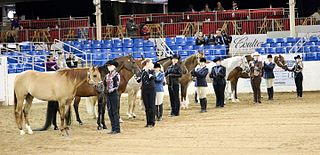
Showmanship is an event found at many horse shows. The class is also sometimes called "Fitting and Showmanship", "Showmanship In-Hand", "Showmanship at Halter" or "Halter Showmanship" It involves a person on the ground leading a horse, wearing a halter or bridle, through a series of maneuvers called a pattern. The horse itself is not judged on its conformation. Exhibitors are judged on exhibiting the animal to its best advantage, with additional scoring for the grooming and presentation of both horse and handler.

The forelock or foretop is a part of a horse's mane, that grows from the animal's poll and falls forward between the ears and onto the forehead. Some breeds, particularly pony breeds, have a naturally thick forelock, while other breeds, such as many Thoroughbreds, have a thinner forelock. Primitive wild equines such as the Przewalski's horse with a naturally short, upright mane generally have no hair falling forward onto the forehead. Other equidae such as donkeys and zebras, have no discernible forelock at all.
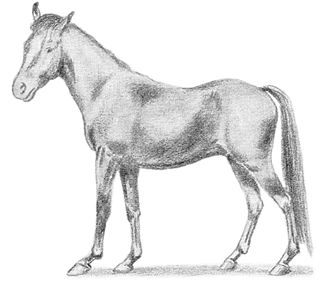
The Manipuri Pony is a traditional Indian breed of small horse or pony from Assam and Manipur in north-eastern India. It appears both in the history and the mythology of Manipur, and was used for warfare and polo. It is believed to have been the polo pony in use in Assam in the mid-nineteenth century when British tea planters first saw polo being played, and the height limits set for polo ponies were based on ponies of this breed. It was very numerous in the early twentieth century, but numbers have since fallen. A breed society was established in 1977, and a breed standard was drawn up by the Indigenous Horse Society of India in 2009.

On horses, the mane is the hair that grows from the top of the neck of a horse or other equine, reaching from the poll to the withers, and includes the forelock or foretop. It is thicker and coarser than the rest of the horse's coat, and naturally grows to roughly cover the neck. Heredity plays a role, giving some horses a longer, thicker mane, and others a shorter, thinner one.

Halter is a type of horse show class where horses are shown "in hand," meaning that they are led, not ridden, and are judged on their conformation and suitability as breeding stock. Depending on breed and geographic region, such events may be called "Halter," "In-Hand," "Breeding," "Model," or "Conformation" classes.

Horse grooming is hygienic care given to a horse, or a process by which the horse's physical appearance is enhanced for horse shows or other types of competition.

The show hack is a type of ridden show horse, exhibited to a standard first established in England.

Mountain and moorland ponies form a group of several breeds of ponies and small horses native to the British Isles. Many of these breeds are derived from semi-feral ponies kept on moorland or heathland, and some of them still live in this way, as well as being kept as fully domesticated horses for riding, driving, and other draught work, or for horse showing.

A pony is a type of small horse. Depending on the context, a pony may be a horse that is under a given height at the withers, or a small horse with a specific conformation and temperament. Compared to a larger horse, a pony may have a thicker coat, mane and tail, with proportionally shorter legs, a wider barrel, heavier bone, a thicker neck and a shorter, broader head. The word pony derives from the old French poulenet, meaning foal, a young, immature horse.
Cowboy polo is a variation of polo played mostly in the western United States. Like regular polo, it is played in chukkas (periods) with two teams on horses who use mallets to hit a ball through a goal. It differs from traditional polo in that five riders make up a team instead of four, western saddles and equipment are used, and the playing field is usually a simple rodeo arena or other enclosed dirt area, indoors or out. Also, instead of the small ball used in traditional polo, the players use a large red rubber medicine ball and use mallets with long fiberglass shafts and hard rubber heads.

The tail of the horse and other equines consists of two parts, the dock and the skirt. The dock consists of the muscles and skin covering the coccygeal vertebrae. The term "skirt" refers to the long hairs that fall below the dock. On a horse, long, thick tail hairs begin to grow at the base of the tail, and grow along the top and sides of the dock. In donkeys and other members of Equus asinus, as well as some mules, the zebra and the wild Przewalski's horse, the dock has short hair at the top of the dock, with longer, coarser skirt hairs beginning to grow only toward the bottom of the dock. Hair does not grow at all on the underside of the dock.
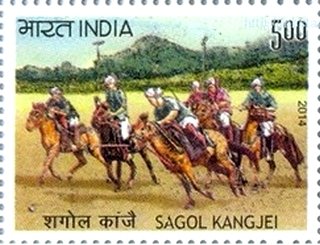
Sagol Kangjei is a traditional Meitei ball sport played on horseback with a long-handled stick. The sport, also known as Manipuri polo, is a predecessor of modern international polo.

